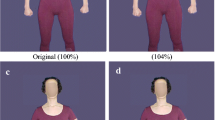Abstract
AIM: To validate a silhouette-based scale, the Body Image Dimensional Assessment (BIDA), an instrument for the screening of body dissatisfaction in large samples. MATERIALS AND METHODS: Five-hundred ninety-two both gender non-clinical participants and 57 patients with eating disorders (ED) were administered the BIDA and the Body Dissatisfaction subscale of the Eating Disorder Inventory 2 (BD-EDI2). The BIDA consists of only 4 items to answer with reference to a series of four silhouettes not age- nor gender-related using a numeric scale that allows the quantification of the degree of Body Dissatisfaction, Sexual Body Dissatisfaction, Comparative Body Dissatisfaction and the calculation of the final Body Dissatisfaction Index (BDI). RESULTS AND CONCLUSIONS: The study has shown that the BIDA has good reliability and validity as well as high predictive capability at a threshold BDI≥30 (sensitivity =83.3% and specificity =92.1%). By virtue of the rapid timing of administration, the BIDA can be a useful screening instrument of body dissatisfaction in non clinical populations to detect people at risk for ED and a follow-up instrument in clinical setting.
Similar content being viewed by others
References
Paxton SJ. Individual risk factors. In: Gaskill D, Sanders F (Eds) The encultured body — Policy implications for healthy body image and disordered eating behaviours. Brisbane, Queensland University of Technology, 2000, pp 24–33.
American Psychiatric Association. Diagnostic and statistical manual of mental disorders, Fourth Edition, Text Revision (DSM-IV-TR). Washington, DC, American Psychiatric Association, 2000.
American Psychiatric Association. DSM-5 development. Feeding and eating disorders. http://www.dsm5.org/ProposedRevision/Pages/FeedingandEatingDisorders.aspx downloaded august 2011.
Shroff HP, Calogero RM, Thompson JK. Assessment of body image. In: Allison DB, Baskin ML (Eds) Handbook of assessment methods for eating behaviors and weight-related problems. Measures, theory and research. Thousand Oaks, Sage Publications, 2009, pp 115–36.
Cash TF, Brown TA. Body image in anorexia nervosa and bulimia nervosa: a review of the literature. Behav Modif 1982; 11: 487–521.
Lautenbacher S, Thomas A, Roscher S, et al. Body size perception and body satisfaction in restrained and unrestrained eaters. Behav Res Ther 1992; 30: 243–50.
Skrzypek S, Wehmeier PM, Remschmidt H. Body image assessment using body size estimation in recent studies on anorexia nervosa. A brief review. Eur Child Adolesc Psychiatry 2001; 10: 215–21.
Striegel-Moore RH, Franko DL, Thompson D, et al. Changes in weight and body image over time in women with eating disorders. Int J Eat Disord 2004; 36: 315–27.
Stunkard A. Old and new scales for the assessment of body image. Percept Mot Skills 2000, 90: 930.
Bulik CM, Wade TD, Heath AC, et al. Relating body mass index to figural stimuli: population-based normative data for Caucasians. Int J Obes Relat Metab Disord 2001; 25: 1517–24.
Túry F, Güleç H, Kohls E. Assessment methods for eating disorders and body image disorders. J Psychosom Res 2010; 69: 601–11.
Gardner RM. Assessment of body image disturbance in children and adolescents. In: Thompson JK, Smolak L (Eds) Body image, eating disorders, and obesity in youth. Washington, DC, American Psychological Association, 2001, pp 193–213.
Thompson JK, Heinberg LJ, Altabe M, et al. Exacting beauty: theory, assessment, and treatment of body image disturbance. Washington, DC, American Psychological Association, 1999.
Keeton WP, Cash TF, Brown TA. Body image or body images? Comparative, multidimensional assessment among college students. J Pers Assess 1990; 54: 213–30.
Garner, DM. Eating Disorder Inventory 2. Professional manual. Odessa, FLm Psychological Assessment Resources, 1993.
World Health Organization. BMI classification (2006). http://apps.who.int/bmi/index.jsp?introPage=intro_3.html 2011 June.
Bully P, Elosua P. Changes in body dissatisfaction relative to gender and age: the modulating character of BMI. Span J Psychol; 14: 313–22.
Schneider N, Martus P, Ehrlich S, et al. The assessment of body image distortion in female adolescents with anorexia nervosa: The development of a test for Body Image Distortion in Children and Adolescentes (BIDCA). EatWeight Disord 2009; 14:e128–36.
Núñez-Navarro A, Agüera Z, Krug I, et al. Eating disorders differ from women in clinics, psychopathology and personality? Eur Eat Disord Rev 2012; 20: 23–31.
Grilo CM, Masheb RM. Correlates of body image dissatisfaction in treatment-seeking men and women with binge eating disorder. Int J Eat Disord 2005; 38: 162–6.
Blashill AJ. Gender roles, eating pathology, and body dissatisfaction in men: a meta-analysis. Body Image. 2011, 8: 1–11.
Mohnke S, Warschburger P. Body dissatisfaction among female and male adolescents: comparing prevalence, predictors, and consequences between the sexes. Prax Kinderpsychol Kinderpsychiatr 2011; 60: 285–303.
Wang Y, Liang H, Chen X. Measured body mass index, body weight perception, dissatisfaction and control practices in urban, low-income African American adolescents. BMC Public Health 2009; 9: 183.
Author information
Authors and Affiliations
Corresponding author
Rights and permissions
About this article
Cite this article
Segura-García, C., Papaianni, M.C., Rizza, P. et al. The development and validation of the Body Image Dimensional Assessment (BIDA). Eat Weight Disord 17, e219–e225 (2012). https://doi.org/10.3275/8271
Received:
Accepted:
Published:
Issue Date:
DOI: https://doi.org/10.3275/8271




